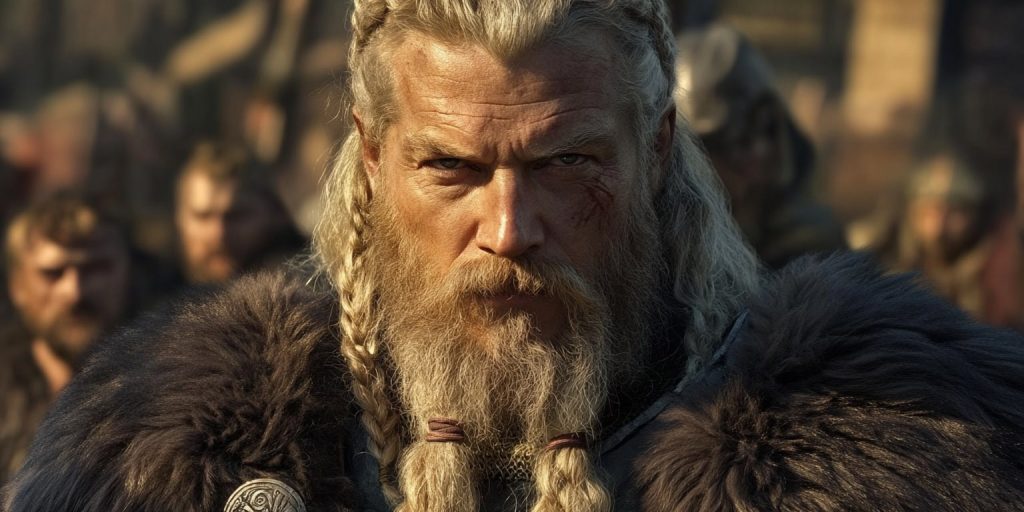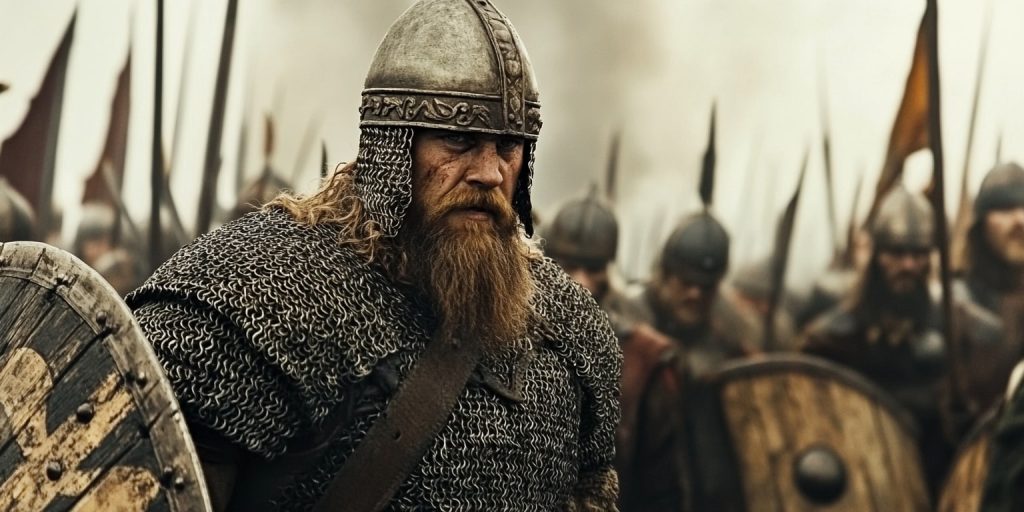Viking Heritage, Viking Raids and Warfare, Vikings
The Legacy of German Vikings: Myth or Reality in Norse History?
The Viking Age saw many cultures meet, including the Nordic Bronze Age culture, sparking debates. One big question is if German Vikings existed in Norse history as part of the North Germanic people. We’ll look into how Germanic tribes might have mixed with Scandinavian Vikings.
This mix could have greatly changed Viking history. Did Germanic tribes join forces with Scandinavian Vikings? Are Vikings German? These questions make us think again about these famous sea warriors and their lasting impact on German territory.
The Historical Context of Germanic Tribes
The Germanic peoples have been a big part of European history. They came from Northern Europe, particularly from Scandinavia and Northern Germany. Their languages and migrations shaped the continent.
Records show Germanic tribes started moving around 1000 BCE. They didn’t just move in one direction; the Vikings settled in various European regions, from Scandinavia to the Black Sea.
Their impact on history is huge, particularly in shaping the Germans’ and Scandinavian identities. They helped create many European languages, including those influenced by High German. Their languages mixed with politics and society, changing local cultures.
Important tribes like the Goths, Vandals, Saxons, and Franks played big roles. The Goths, for example, attacked Rome in 410 AD. The Franks helped create France and Germany.
Their moves set the stage for the Viking Age. Germanic tribes brought their culture, social systems, and military tactics. These helped the Vikings shape Northern Europe’s history.
In short, the various Germanic tribes left a lasting mark on the Nordic Bronze Age culture. From Northern Europe to across the continent, their languages and migrations, including Germanic languages, are still seen in European history.
Germanic Influence on Viking Culture
Old Norse and early Germanic dialects show a strong bond. This bond goes beyond words, touching cultural practices and beliefs.
Language Similarities
Old Norse, the Viking language, has ties to Germanic dialects. They share words and structures, showing a common heritage. This shows the deep connection between Scandinavian and Germanic cultures.
Cultural Practices
Viking society, particularly among the Norse people, was shaped by Germanic traditions. They shared skills in metalwork and shipbuilding, reflecting the advanced techniques of the Nordic Bronze Age. Their governance systems, like thing assemblies, also show similarities.
Religious Beliefs
Norse people’s beliefs were shaped by Germanic paganism, prevalent during the Iron Age. They both revered gods like Odin and Thor. Their rituals and festivals reflect this shared spiritual base.
Were there German Vikings?
Many have puzzled over whether Vikings were German. To answer this, it’s key to look at history and geography. This helps us see if people from today’s Germany were Vikings.
Northern Germany was close to Scandinavia in culture and language. This makes people wonder – what were German Vikings called? Some say they were ‘Saxon’ or ‘Frisian’ Vikings, named after Germanic tribes.
Records and digs show Vikings in Northern Germany. They found signs of raids, sea travel, and Viking settlements, which shows that the area was important in the Viking world, with warriors, traders, and settlers.
This makes us ask: Were Vikings German or influenced by their neighbors? Knowing the German Vikings’ names helps us understand their interactions and growth.
Migration Patterns: Vikings and Germanic Peoples
The migration of Viking Age inhabitants and Germanic peoples greatly changed Europe’s history. These movements included Viking raids and settlements. They affected many regions where Germanic tribes moved.

Migration During the Viking Age
Scandinavian Vikings traveled far across Europe during the Viking Age, looking for new lands and resources. Their migration was caused by many factors, including too many people, political problems, and economic opportunities.
- Scandinavian Vikings sailed to the British Isles, establishing notable settlements in York and Dublin.
- Significant migrations also led Vikings to the coastal areas of France, where they founded the Duchy of Normandy.
- Explorations reached the Mediterranean, with Viking presence recorded in regions such as Italy and the Byzantine Empire.
Settlement in Various European Regions
The places where Germanic tribes migrated also saw big changes. Viking raids were often followed by permanent communities that mixed with local societies.
- The British Isles: Viking settlements changed the language and culture here, with effects still seen in modern English.
- Northern France: The Vikings’ founding of Normandy brought big changes in politics and society.
- Eastern Europe: Viking settlers known as the Rus were key in forming early Russian and Ukrainian states.
The lasting impact of Viking Age inhabitants, including Danish Vikings, and their migrations is still seen in European culture today. Their migrations shaped new settlements and influenced local traditions. The migration patterns of Scandinavian Vikings and various Germanic tribes left a lasting mark on the continent’s history.
Archaeological Evidence of German Vikings
Archaeologists have found ample proof that Vikings lived in Germany. This shows that they had strong ties with other parts of Northern Europe. Many Viking archaeological sites in Germany give us clues about their shared past.
The Viking artifacts found at places like Haithabu are fascinating. They include swords, tools, jewelry, and more. These items show the Vikings’ skills and the cultural exchange they had.
Grave sites in Schleswig-Holstein also tell us a lot. They show practices of both Viking and Germanic ancestry. These graves have weapons and ornaments, showing Viking traditions and local customs.
Settlement remains also give us important clues. Excavations have found longhouses and defenses that look like Viking buildings. This shows that Germanic people and Vikings worked together, particularly during the Nordic Bronze Age.
The mix of cultures in these areas shows how much Vikings influenced Germany. This large collection of finds helps us better understand Northern European history.
German Vikings in Historical Texts
Many historians have studied German Vikings, often called Vikings. They’ve examined Norse sagas, Viking chronicles, and Roman records, which tell us about Germanic tribes and their role in Viking societies.
Sagas and Chronicles
The Norse sagas and Viking chronicles are full of exciting stories. They discuss Viking adventures and societies and mention Germanic tribes, showing their cultural and language ties.
These stories share tales of raids and settlements. They show how Germanic tribes and Viking leaders worked together and fought each other.
Roman Empire Records
Roman records give us another view, showing their battles with Germanic tribes. These texts are key to understanding Germanic tribes’ interactions with other European powers. They highlight the tribes’ military skills and social structures.
By looking at these Roman records, historians learn more about Germanic tribes’ role in the Viking era and how these ancient cultures were connected.
The Legacy of German Vikings in Modern Europe
The German Vikings have left a mark on European culture and identity. This section will examine their impact in Germany and Scandinavian countries, particularly focusing on the North Germanic people. It will explore the historical and cultural ties between Scandinavia and Northern Germany that still exist today.

Impact on Modern German Culture
German Viking heritage is evident in today’s culture. Architecture, folklore, and festivals connect the Viking Age to the present, displaying a mix of old traditions and new ideas.
Influence on Scandinavian Countries
Scandinavian countries share a deep Viking history with Germany. Countries like Sweden, Norway, and Denmark celebrate their Norse heritage. This is seen in their languages, sea traditions, and government systems.
Shared Heritage Today
German and Scandinavian peoples share a strong heritage. Modern German and Scandinavian cultures show a love for their Viking roots. This is seen in schools and cultural events. It shows the Vikings’ lasting impact on Europe.
Skepticism and Debate Among Historians
The debate on Vikings among historians is lively. It centers on whether Vikings were German. This question concerns how we interpret historical evidence and the mix of Germanic tribes and Viking culture.
It’s difficult to follow the history of these groups because of their cultural exchange. Some say they shared customs and spoke a Germanic language, but others see big differences in their ways of life and societies.
Archaeological finds are key in this debate. They either support or challenge the idea of German Vikings. Scholars examine artifacts and settlements but often find more mysteries than answers.
New research methods, like genetics and advanced archaeology, are changing the game. They give us clearer views, helping to solve old debates about the various Germanic tribes. This leads to a deeper understanding of the Viking history.
Summary
The connection between Vikings and Germanic tribes tells us much about early Europe. We started by learning about the Germanic tribes and then saw how they influenced Viking culture.
Their languages, customs, and beliefs are very similar, reflecting the shared heritage of the Norse people and Germanic tribes. This shows a strong bond between the Norse and Germanic people.
Our search into German Vikings took us through their migrations and the evidence they left behind. These migrations and settlements show how these groups overlapped. Historical texts like sagas and Roman records also shed light on their ties.
Today, we still see the impact of German Vikings on culture and heritage in Germany and Scandinavia. Historians debate, but their talks help us understand more. The findings show that Vikings and Germanic tribes have a deep history together.
This history is important for understanding Europe’s past and culture. It shows a rich and connected past that still influences us today.

